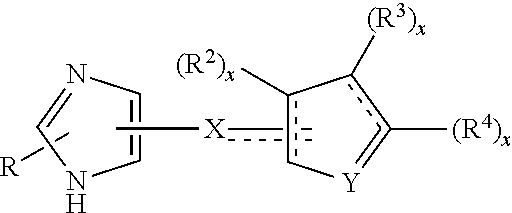Functionally selective azanitrile alpha-2c adrenoreceptor agonists
a technology of azanitrile and adrenergic activity, applied in the field of azanitrile compounds, can solve the problems that compounds having adrenergic activity, such as 2a agonists, may be associated with undesirable side effects, and achieve the effect of minimizing adverse side effects
- Summary
- Abstract
- Description
- Claims
- Application Information
AI Technical Summary
Benefits of technology
Problems solved by technology
Method used
Image
Examples
example 1
Preparative Example 1
[0496]
Steps 1-3
[0497]
[0498]7-azaindoline was sequentially treated with mCPBA (J. Org. Chem. 1980, 45, 4045), TMSCN / benzoyl chloride (Synthesis, 1992, 661) and LiOH (J. Agric. Food Chem. 1997, 45, 2345) to provide 6-cyano-7-azaindole 1A. The formation of compound 1A is also described in the literature by alternate approaches (Synthesis 2008, 201 and Synthesis, 2008, 707).
Step 4
[0499]
[0500]A solution of 1A (45 mg, 0.3 mmol) in THF (5 mL) and DMF (1 mL) was treated with NaH MDS (1 M / THF, 1.5 mL) and stirred at RT for 30 min. NaI (45 mg, 0.3 mmol) and 4-(chloromethyl)-1-tritylimidazole (0.3g, 0.9 mmol) were then added. The reaction was stirred overnight at RT and then concentrated. Chromatography (20-50% EtOAc / hex) provided 1B (72 mg, 50%) and recovered starting material 1A (23 mg, 50%)
Step 5
[0501]
[0502]A solution of 1B (70 mg, 0.15 mmol) in DCM (10 mL) was treated with TFA (0.06 mL, 0.75 mmol) and Et3SiH (0.03 mL, 0.15 mmol). Chromatography (PTLC, 5% of 7N NH3-MeOH...
example 2
Preparative Example 2
[0503]
Step 1
[0504]To a stirred mixture of 2-bromo-3-pyridinol (20 g, 115 mmol, 2A) and 3-butenol (10 mL, 117 mmol) in 460 mL of anhydrous THF at 0° C. was added PPh3 (36.14 g, 138 mmol) followed by diethylazodicarboxylate (19.9 mL, 126.4 mmol). The cooling bath was removed after 10 min. The mixture was heated at reflux over night, and then concentrated in vacuo to dark brown oil. The oil was dissolved in 500 mL of EtOAc, washed with a sat. NaHCO3 aq. solution and brine, dried with Na2SO4, and concentrated in vacuo to a mixture of oil and solid. The crude product mixture was dissolved in ˜120 mL of CH2Cl2; the white solid was removed by filtration. The filtrate was purified by flash column chromatography eluting with 10% EtOAc in hexanes to afford 18.76 g of 2B (72%) as a near colorless oil.
Step 2
[0505]A solid mixture of PPh3 (6.48 g, 24.7 mmol), palladium acetate (1.85 g, 8.22 mmol), potassium acetate (40.36 g, 411.2 mmol), and tetraethylammonium chloride hydrat...
PUM
| Property | Measurement | Unit |
|---|---|---|
| temperature | aaaaa | aaaaa |
| temperature | aaaaa | aaaaa |
| v/v | aaaaa | aaaaa |
Abstract
Description
Claims
Application Information
 Login to View More
Login to View More - R&D
- Intellectual Property
- Life Sciences
- Materials
- Tech Scout
- Unparalleled Data Quality
- Higher Quality Content
- 60% Fewer Hallucinations
Browse by: Latest US Patents, China's latest patents, Technical Efficacy Thesaurus, Application Domain, Technology Topic, Popular Technical Reports.
© 2025 PatSnap. All rights reserved.Legal|Privacy policy|Modern Slavery Act Transparency Statement|Sitemap|About US| Contact US: help@patsnap.com



